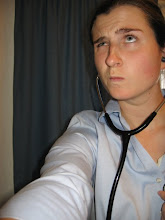This week was awesome. I asked to be placed in the delivery ward of the hospital for uncomplicated cases (there is another ward where complicated cases, such as breach presentation, hypertension, twins, etc are referred) with the hope that I might be able to assist in some deliveries and perhaps deliver a baby (supervised, of course) at the end of the week. The week was by all accounts a success, but it was definitely stressing at times. I got to watch so many births. There weren't any doctors in this delivery ward, but there were about 5 or 6 midwives and a third year medical student. About a couple hours after I arrived in the ward, the third year medical student let me watch while she delivered a baby. She was really good about explaining every step and helping me understand why they did things certain ways. Apparently, one of the most important things to do during the delivery process is to give a shot of oxytocin within 1 minute of the delivery. The third year medical student also taught me how to deliver the placenta with continuous cord traction. She also taught me the basics of delivery and how to minimize tearing and what position to hold the baby. Did I mention it was amazing?
The delivery process itself is surprising fluid-involved. By "fluid-involved" I mean that every fluid that could possibly come out of your body comes out during the delivery of a baby. [Warning: Don't read if you are eating lunch]. First the expectant mother must urinate and empty her bowels to allow maximum room for the baby to descend. The delivery process may or may not be accompanied with vomiting from the mother. Then the delivery itself is accompanied by large amounts of blood and amniotic fluid. Profuse sweating also takes place by the mother while she is pushing. The baby usually defecates as well sometime during the process, making the circle of bodily fluids complete. However, despite these many possibly offensive odors, I found the delivery ward a surprising pleasant place to spend time in and birth a miraculous processes.
Anyway, sorry about my rambling. You might be wondering why I have entitled this entry, "Unreasonable fear." I have entitled the entry thus, because of an experience I had on my third day in the delivery ward. Early on in the morning, a midwife assigned me to monitor a woman who was HIV positive and on HAART (Highly Active Anti-Retroviral Therapy). I looked forward to monitoring this woman and possibly being present while she delivered. I was not concerned about her HIV status as many women in the ward are infected with HIV, and just noted to myself to be extra careful to wear double gloves anytime I had to contact bodily fluids.
A couple hours later, the woman in the bed next to my patient started pushing and a midwife told me to quickly draw a syringe of oxytocin. The oxytocin are in little glass vials that each contain 1 dose of the medication. The women bring their own gloves, cotton, syringes, plastic sheets to deliver on and clothes for the baby. I quickly got a dose of oxytocin from the supply cupboard, put on a pair of clean gloves and used a piece of cotton to break open the vial of oxytocin. Then I opened a package with a sterile syringe and needle. However, while I was trying to un-cap the needle I accidentally stuck myself with the tip of the needle. I instantly froze and my pulse went up to about 250 beats per minute as I started to feel a small trickle of blood go down my finger inside my glove. I was so scared. I had just stuck myself with a needle! It didn't matter that it was a clean, sterile needle and my hand was clean and covered with a clean glove. All the secret fear of a needle stick came to me in a flood. What if I had just finished giving the injection to my HIV positive patient when I accidentally stuck myself? For the first time since Annie's blood-splash scare, I was glad that the UW made us bring HIV prophylaxis with us. I took a couple deep breaths, and then dropped the contaminated needle/syringe in the sharps container. With slightly trembling hands I successfully filled a new syringe with oxytocin and handed it to the midwife. I then excused myself and washed my hands about 5 times and called Annie (who was rotating in endocrinology) and asked if she wanted to have lunch.
During lunch Annie was really nice about listening to me and was very reassuring when she told me that a needle stick with sterile needle into a clean gloved finger is actually safer than cutting yourself in the kitchen with a knife. I am now fine and completely calm. It was just rattling to realize how easy it would be to stick yourself with an infected needle.
Coming soon, from Pixar…
9 years ago




No comments:
Post a Comment